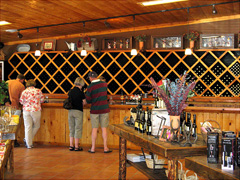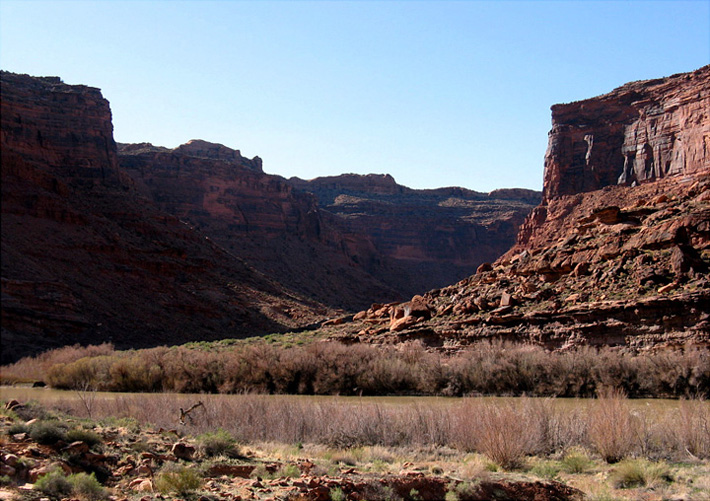Castle Creek Winery, Moab, Utah – April 9, 2010
I traveled in early April to southern Utah, visiting the beautiful canyon country that includes Zion, Bryce, Capitol Reef, Canyonlands, and Arches National Parks in addition to other natural wonders. Wine was not really on the agenda for this trip, but after learning that my intended driving route one day would take me right past a winery, I couldn’t help but stop to check it out.
After visiting Arches National Park, I left the Moab, Utah area along Highway 128, which follows the Colorado River through a beautiful canyon. About 15 miles northeast of Moab I came to Castle Creek Winery, located at Red Cliffs Ranch. I’d known there were a couple of wineries in the area for some time, but this was my first visit to one – and first time tasting Utah wines.
The history of wineries in Utah is a very short one. It was not until 1988 that it became legal to make or sell wine commercially in the state. Farmers in the Moab area actually began planting wine grapes in the early 1980s, based on successful test plantings in the ‘70s. Not surprisingly, the climate in the Moab area is quite hot during the summer days, but like many high desert areas – elevations in most of the growing areas are over 4,000 feet – it often cools off significantly at night, making wine grape cultivation feasible, and the dry climate helps reduce fungus and rot concerns. The first harvest of Moab-area wine grapes was in 1986, but with no commercial wineries permitted in the state at that time, they were sold to wineries in the Grand Junction, Colorado area.
CURRENT RELEASES:
|
Chardonnay: An intriguing wine that was very tasty, despite not being all that Chardonnay-like. Light citrus notes are the first impression, with slightly spicy, minerally components following. Not anything like most California Chards, this was lighter on the palate with a refreshing if not very long finish. I brought a bottle home with me and I poured it at a blind tasting with some wine friends – their guesses included a Rhône white, Italian white, or Sancerre! Regardless, this was an eye-opener for a Utah wine.
“Uintah Blanc”: Made from Muscat grapes, this had plenty of the distinctive floral, perfumey Muscat character – stronger than I care for, but I can see that this would appeal to people who like that style more than I do. The flavors echoed the aromas, and the wine finished fairly sweet.
“Lily Rose White”: A blend of Gewürztraminer & Muscat, this showed the floral notes of the Muscat along with the spice and lychee fruit of the Gewürz. While the Muscat was more dominant on the nose, I thought the Gewürztraminer was more noticeable on the palate, helping to tone down the Muscat perfume. While this wine was also moderately sweet, it seemed less so than the “Uintah Blanc,” and I preferred the “Lily Rose White” of the two.
“Outlaw Red”: A blend of Souzão, Petite Sirah, Cabernet Franc, this had a medium purple color along with an expressive nose of darker fruits and spice. Medium-bodied and fairly lively in the mouth, it had only mild tannins on the finish. This was a pleasant, fruity everyday blend, a good picnic or burger wine, and my favorite of Castle Creek’s reds.
Merlot: Lighter color, with a shy nose of red fruits that didn’t quite hit the mark for what I’d expect from a Merlot. The weight on the palate was also quite light, and the finish was short – my least favorite wine among the reds I tasted.
Cabernet Sauvignon: Medium color, with darker fruit and herb notes – unlike the Merlot, the aromas were easily recognizable for the variety. On the lighter side in the mouth for a Cabernet, this was still more full-bodied than the Merlot, and a pleasant wine for near-term drinking.
|
|
Castle Creek traces its beginnings to Arches Winery, which was founded in 1989. The winery moved to its current location and changed name to Castle Creek in 1998. Red Cliffs Ranch also includes a lodge, restaurant, small museum, and other amenities. The winery planted ten acres of Cabernet and Syrah vines at their vineyard adjacent to their facility in 2006. In addition to their own vineyard, all other fruit for the wines in sourced from growers in the area. Current production is close to 10,000 cases per year.
The tasting room is large and inviting, with a long wood bar – the length of which probably attests to the number of visitors the winery must host during the busier tourist months in the area. The Castle Creek wines are labeled without a vintage date, though they’re typically made from a single vintage rather than blended from multiple ones. I was told that the wines I tasted were mainly from the 2008 vintage.
Castle Creek had a few wines on their list of current releases that I didn’t taste on my visit – a Chenin Blanc, a Merlot/Cab blend called “Kid Red,” and a Late Harvest Gewürztraminer. Going in, I have to say I wasn’t expecting a whole lot from the wines, but overall they were a pleasant surprise. All were well-made, and most showed very recognizable varietal character. While these were not great wines by any means, most were certainly likable, and a couple of them transcended the novelty of being Utah wines. I thought the Chardonnay and “Outlaw Red” were the standouts of the line-up, and at prices in the $9-13 range, they’re pretty good values too. It’s worth the short and scenic drive to the winery if you happen to be visiting the national parks in the Moab area.
A brief postscript: Having traveled to southern Utah’s canyon country a number of times over the years, I have not come to expect much from restaurants in the area, other than in heavily-touristed Moab. So I was amazed at the excellent food at Hell’s Backbone Grill in the tiny town of Boulder – pretty much in the middle of nowhere along Highway 12 (which is arguably the most scenic road in the country), in the general vicinity of Capitol Reef National Park. The food and service would not seem out of place for a good restaurant in the San Francisco Bay Area, so if you ever find yourself in that neck of the woods, by all means stop in for a meal.
[Additional Reviews & Journals from Ken Zinns]
|



